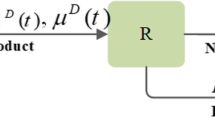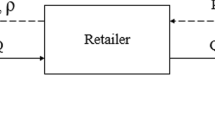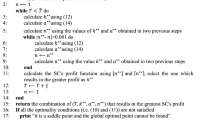Abstract
In this paper, supply chain deals with a single manufacturer and a single retailer. A manufacturer employs innovation and a retailer employs promotional efforts to elevate the demand and sales of their respective products. The following paper uses decentralized and centralized models to analyze supply chain for innovation, promotional efforts, and replenishment time, when stocks deteriorate at a constant rate considering trapezoidal demand of the product, which depends on the manufacturer’s innovation and the retailer’s promotional efforts. It is found that the total profit of supply chain improves with joint decisions; however, it reduces individual profit. The individual profit of the retailer decreases due to centralized approach, and therefore, the manufacturer tries to lure the retailer through discounts in the selling price of the product, trade credit, and profit sharing. Due to these types of offers, retailer is ready to take part into joint decision. As a result, supply chain maximizes their profit centrally. The following paper aims to optimize the total profit of supply chain keeping in view of the manufacturer’s innovation efforts, the retailer’s promotional efforts, and replenishment time. The model is supported by numerical examples, applies sensitivity analysis to deduce managerial insights, and concludes on working in coordination for optimal profit/benefits.




Similar content being viewed by others
References
Bai Q-G, Xu X-H, Chen M-Y, Luo Q (2015) A two-echelon supply chain coordination for deteriorating item with a multi-variable continuous demand function. Int J Syst Sci Oper Logistics 2(1):49–62
Bai Q, Chen M, Xu L (2017) Revenue and promotional cost-sharing contract versus two-part tariff contract in coordinating sustainable supply chain systems with deteriorating items. Int J Prod Econ 187(January):85–101
Banerjee A (1986) A joint economic lot size model for purchaser and vendor. Decis Sci 17(3):292–311
Buratto A, Grosset L, Viscolani B (2007) Advertising coordination games of a manufacturer and a retailer while introducing a new product. TOP 15(2):307–321
Cárdenas-Barrón LE, Sana SS (2014) A production-inventory model for a two-echelon supply chain when demand is dependent on sales teams’ initiatives. Int J Prod Econ 155(2014):249–258
Cárdenas-Barrón LE, Sana SS (2015) Multi-item EOQ inventory model in a two-layer supply chain while demand varies with a promotional effort. Appl Math Model 39(21):6725–6737
Cheng M, Zhang B, Wang G (2011) Optimal policy for deteriorating items with trapezoidal type demand and partial backlogging. Appl Math Model 35:3552–3560
Chung KJ, Cárdenas-Barrón LE (2013) The simplified solution procedure for deteriorating items under stock-dependent demand and two-level trade-credit in the supply chain management. Appl Math Model 37(7):4653–4660
Ge Z, Hu Q, Xia Y (2014) Firms' R&D cooperation behavior in a supply Chain. Prod Oper Manag 23(4):599–609
Gilbert SM, Cvsa V (2003) Strategic commitment to price to stimulate downstream innovation in a supply chain. Eur J Oper Res 150(3):617–639
Goyal SK (1976) An integrated inventory model for a single supplier-single customer problem. Int J Prod Res 15(1):107–111
Hill RM (1997) The single-vendor single-buyer integrated production-inventory model with a generalized policy. Eur J Oper Res 97(3):493–499
Huang CK (2004) An optimal policy for a single-vendor single-buyer integrated production-inventory problem with process unreliability consideration. Int J Prod Econ 91(1):91–98
Jørgensen S, Zaccour G (2014) A survey of game-theoretic models of cooperative advertising. Eur J Oper Res 237(1):1–14
Karray S (2015) Cooperative promotions in the distribution channel. Omega 51(2015):49–58
Littler D, Melanthiou D (2006) Consumer perceptions of risk and uncertainty and the implications for behavior towards innovative retail services: the case of internet banking. J Retail Consum Serv 13(6):431–443
Ma P, Wang H, Shang J (2013) Contract design for two-stage supply chain coordination: integrating manufacturer-quality and retailer-marketing efforts. Int J Prod Econ 146(2):745–755
Mishra U, Tijerina-Aguilera J, Tiwari S, Cárdenas-Barrón LE (2018) Retailer’s joint ordering, pricing and preservation technology investment policies for a deteriorating item under permissible delay in payments. Math Probl Eng 2018:14
Nagaraju D, Rao AR, Narayanan S (2016) Centralized and decentralized three echelon inventory model for optimal inventory decisions under price dependent demand. Int J Logist Syst Manag 23(2):147–170
Nematollahi M, Hosseini-Motlagh SM, Heydari J (2017) Coordination of social responsibility and order quantity in a two-echelon supply chain: a collaborative decision-making perspective. Int J Prod Econ 184(2017):107–121
Nouri M, Motlagh SMH, Nematollahi M, Sarker BR (2018) Coordinating manufacturer’s innovation and retailer’s promotion and replenishment using a compensation-based wholesale price contract. Int J Prod Econ 198(2018):11–24
Ouyang LY, Chuang CJ, Ho CH, Wu CW (2014) An integrated inventory model with quality improvement and two-part credit policy. TOP 22(3):1042–1061
Shah NH, Jani MY, Chaudhari U (2017a) Inventory control Policies for deteriorating item with preservation technology, quadratic demand and trade credit for a single supplier-two retailers supply chain: a centralization vs. decentralization approach. Handbook of research on promoting business process improvement through Inventory Control technic. https://doi.org/10.4018/978-1-5225-3232-3.ch0011
Shah NH, Chaudhari U, Jani MY (2018) Studied optimal control analysis for preservation technology investment, inventory and service. Int J Syst Sci Oper Logist. https://doi.org/10.1080/23302674.2018.1447167
Shah NH, Gor AS, Jhaveri CA (2011) Determination of optimal ordering and transfer policy for deteriorating inventory system when demand is quadratic. Int J Manag Sci Eng Manag 6(4):278–283
Shah NH, Jani MY, Chaudhari U (2017b) Retailer’s optimal policies for price-credit dependent trapezoidal demand under two-level trade credit. Int J Oper Quant Manag 23(2):115–130
Shah NH, Shah DB, Patel DG (2013) Optimal retail price, replenishment time and payment scenario under biddable two-part trade credit for price—sensitive trapezoidal demand. Dyn Contin Discrete Impulsive Syst Ser B Appl Algorithm 20(6b):647–673
Song J, Li F, Wu DD, Liang L, Dolgui A (2017) Supply chain coordination through integration of innovation effort and advertising support. Appl Math Model 49(2017):108–123
Tiwari S, Cárdenas-Barrón LE, Goh M, Shaikh AA (2018) Joint pricing and inventory model for deteriorating items with expiration dates and partial backlogging under two-level partial trade credits in supply chain. Int J Prod Econ 200:16–36
Tsao YC, Sheen GJ (2008) Dynamic pricing, promotion and replenishment policies for a deteriorating item under permissible delay in payments. Comput Oper Res 35(11):3562–3580
Wang J, Shin H (2015) The impact of contracts and competition on upstream innovation in a supply chain. Prod Oper Manag 24(1):134–146
Woo YY, Hsu SL, Wu S (2001) An integrated inventory model for single vendor and multiple buyers with ordering cost reduction. Int J Prod Econ 73(1):203–215
Yang PC, Wee HM (2000) Economic ordering policy of deteriorated item for vendor and buyer: an integrated approach. Prod Plan Control 11(5):474–480
Yenipazarli A (2016) To collaborate or not to collaborate: prompting upstream eco-efficient innovation in a supply chain. Eur J Oper Res 260(2):571–587
Zhang J, Liu G, Zhang Q, Bai Z (2015) Coordinating a supply chain for deteriorating items with a revenue sharing and cooperative investment contract. Omega 56(1):37–49
Acknowledgements
The authors thank reviewer for constructive comments. The first author is thankful to DST- FIST –file # MSI 097 for the financial assistance to carry out this research.
Author information
Authors and Affiliations
Corresponding author
Rights and permissions
About this article
Cite this article
Shah, N.H., Chaudhari, U. & Jani, M.Y. Effect of manufacturer’s innovation and retailer’s promotion under trapezoidal demand with centralized and decentralized options. TOP 27, 55–69 (2019). https://doi.org/10.1007/s11750-018-0492-5
Received:
Accepted:
Published:
Issue Date:
DOI: https://doi.org/10.1007/s11750-018-0492-5




